As experts on all things MG, we’re often called upon to advise customers on the ‘correct’ ride height for their car, with owners wanting to know whether their car might be sitting too high or conversely, too low. This can be a subjective topic, with some owners venturing away from the car’s original ride height, and preferring to tailor to their specific needs. With a methodical approach, we can help owners to achieve their preferred ride height and handling characteristics in as few steps as possible, saving you time and money. Whatever height you’re aiming for, for a road going car (not track or rally) it’s essential the car sits level from front to back and from side to side.
What are you starting from?
Before anything else you need to establish what factors are at play and to identify if there's a problem. To measure the ride height of the car, position the vehicle on flat and level ground. Depending on the model of your MG, there are two approaches; if you have an MGB, C, GT V8 or a 1275/1500 Midget the simplest approach is to measure from the body moulding to the wheel centre. If you have an MGA, early Midget, or MGF/TF you can ascertain the ride height by measuring the sill to the ground taken at points nearest to the front and rear wheels.
Note: Ride heights can only be considered in the context of a laden road car. Don’t be surprised to find that your build isn’t sitting correctly until the engine, transmission, axles, bumpers, tank and interior are installed. Even a full petrol tank can have a marginal bearing on the ride height. In the context of new springs, it’s not uncommon for them to require several thousand road miles before they settle.

If you should find any inconsistency in ride heights whether front to back or across the car, you will need to inspect your suspension components to identify the cause.
Trouble Shooting
What is happening at the rear of the car?
- Tired springs which have lost their shape?
- Asymmetry across the car from Batchelor lean?
- Spring(s) has flattened due to excessive power?
- Wrong springs fitted?
- New springs yet to settle?
- New springs with the spring eye and shackle fixings tightened on the car when unladen?
What is happening at the front of the car?
- Broken?
- Incorrect specification?
- Over-rated springs which push the rear of the car down?
If you are not embarking on a Rubber to Chrome Bumper conversion but instead trying to resolve a ride height issue start by checking the car’s current set-up is correct before seeking replacements. Helpfully you’ll find that the coils springs have been marked with a dash of conspicuous paint, so that you can determine what springs are fitted before any expense is encountered (see chart below). If the rear leaf springs have been changed, you may find a manufacturer's part number or spring rating (given in lbs) painted on the lower leaf. This can be helpful in establishing whether the springs have sagged from age/use or if the wrong springs were fitted. For example, due to non-availability of Midget 1275 springs spanning 5+ years, we’ve seen many examples of those cars being fitted with later rubber bumper Midget 1500 springs. Hobson’s choice does have its part to play in confusing the picture. Remember, it doesn’t always follow that what you have on the car is right particularly if you’re not the first owner.
 Example of a non-standard spring assembly - Example shows incorrect assembly.
Example of a non-standard spring assembly - Example shows incorrect assembly.
Sometimes the right springs are ‘wrong’ for the car. For example, some find that AHH6451 MGB Roadster Coil Springs specified for 1962 to 1970 built cars are just too soft, so we tend to recommend customers purchase the later MGB Roadster spring, BHH1225 instead. Our earlier springs are made to the correct gauge and free length, returning the correct spring rating but lack the robustness of the later factory spring. In fact, this was an issue first encountered by US importers, who on unloading MGB Roadsters at the dockside found that the front suspension had collapsed, this pointed to the original coil springs being inherently weak for application. A point which wasn’t lost by MG who duly lengthened the spring by 0.3” to compensate!
For MGA some suppliers have been specifying the wrong coil springs for the front of the vehicle for many years (recommending early MGB springs which are too tall and soft and lead to the car sitting up at the front and having slightly wallowy front end handling). MGOC Spares is pleased to have commissioned the correct specification coil springs for MGA 1500 from chassis 15152 onwards & all 1600 models offered under part number AHH5546, with 480lb spring rating and 8.88” free length (see table) . Note the coil spring AHH5546 is considered suitable for early MGA 1500s up to chassis 15151. If you should want to lower your MGA, it is possible to lower the ride height at the front by 0.5” by installing CAHT21 rated at 480lbs with 8.63” free length.
With MGB production spanning 18 years, changes in body assembly should be considered. The most notable being in the cross member and spring hangar lengths of Chrome and Rubber Bumper MGs and also with the MGB GT V8, where the car made use of a stepped front cross member, which increased ride height and was later incorporated into all MGB Rubber Bumper iterations, from October 1974 onwards. When the V8 was introduced MG was quoted as saying that the ride height was increased by 1” compared to the four-cylinder cars (remember this was over 12 months before rubber bumper four cylinder models appeared) and whilst the rear springs were specific to the V8 to help secure the rear axle under the much greater V8 engine torque, the front springs were the same as the then current model year four-cylinder chrome bumper GT (BHH1077), so the raised 1” ride height can only come from the modification to the front crossmember where spacing was added to the cross member to body contact points. The difference between a chrome and rubber bumper crossmember is a nominal 27mm, so this certainly accounts for an inch rise.
We can think of the GT V8, produced between 1973 to 1974 as being a halfway house, with the front spring hangars for the rear leaf springs being of rubber bumper specification and the rear swinging shackle mounting was dropped by approximately 55mm. This demanded a very characteristic added ‘bulge’ to the underside of the rear chassis leg. When the rubber bumper V8 arrived the rear spring front mounting position in the body was dropped to the same level as all other rubber bumper cars.
In terms of MGB Roadster ride height, there is the indication from BL spring data that the fitted height of the rubber bumper spring was 0.44” higher than that of the chrome bumper roadster spring and 0.6” higher for the chrome bumper GT, so with slight amplification from leverage principles we have the clue where the extra half inch ride height increase comes from between V8 and rubber bumper four cylinder MGBs. It follows that fitting chrome bumper car springs in a rubber bumper car will not give chrome bumper cars ride heights, but only that half inch or so drop and only if the car remains at the original factory spec, which many are not! They can be lowered but will require lowering blocks and lowered front coil springs.
Rubber bumper cars converted to chrome bumpers in need of replacement springs should choose chrome bumper springs and lowering blocks, the lowering blocks compensate for extra hanger length and the chrome bumper springs to achieve the correct spring rating.
Lowering your Classic MG
There are a number of approaches to lowering your MG. Some degree of trial and error may be necessary to account for varieties in the vehicle setup. For the most part we’ve got you covered, with a range of options available to suit MGBs, MGCs, MGB GTs, GT V8s, Midgets, MGFs & MGTFs.
For MG Midget we offer spacers to lower the coil springs within the spring pan, equating to a 1” approximate reduction in ride height at the front and lowering blocks with elongated u bolts for the rear, designed to lower the rear of a Midget 1275 or 1500 by 1.5” (part number H130).
We also offer fast road performance coil springs for MG Midgets, produced in the UK from high quality spring steel and designed to improve handling without harshness and achieve a lower front ride height. Each spring is manufactured from 13.1mm diameter wire and wound to a 105mm outside diameter. Midget lowered road springs (MST300) are suitable for use on all Midget models. For Chrome Bumper Midgets, this spring will lower front ride height by approx. 0.5". For Rubber Bumper Midgets, the same spring will lower front ride height of 1". The Midget lowered fast road spring (MST310) offers the same spring rating at 340lbs with a reduction in ride height 0.75" for Chrome Bumper cars and 1.5" for Rubber Bumper cars. This spring is best suited for light competition and fast road.
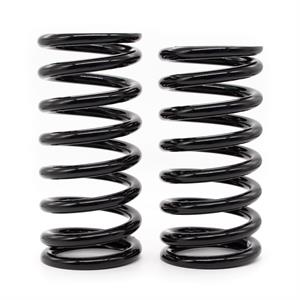
Front Coil Springs
For MGBs, & GTs, V8s, Midgets and MGAs we offer a full range of front coil springs from standard specification to lowered and competition specifications. The published data has been shared to help you make to appropriate selection for your car.
Coil Spring Data
We note the term ‘Free length’ is somewhat abstract in respect of fitted coil springs as it does not provide a useful insight into the final ride height but, it is the case that ride height data is incomplete and is limited to special tuning coil spring data only and not standard coil springs. This follows that the only real way of knowing what’s been fitted is to remove the coil spring, and measure the coil spring free length, coil spring diameter and wire thickness which is where the coil spring data below is of use. Note any values given within this blog in respect of ride height are approximate only.
| Front Spring Part Number |
MG Model |
Chassis # |
Approx. Year |
Spring Rate, lb. " |
Coil Dia, " |
Wire Dia, " |
Free Length, " |
| MM264-330 |
MGA 1500 |
to 15151 |
1955-56 |
348 |
3.238 |
0.498 |
9.75 |
| AHH5546 |
MGA 1500 |
from 15152 |
1956 on. |
480 |
3.28 |
0.54 |
8.88 |
| AHH5546 |
MGA 1600 |
all |
1959 on. |
480 |
3.28 |
0.54 |
8.88 |
| AHH5546 |
MGA MK II |
all |
1961 on. |
480 |
3.28 |
0.54 |
8.88 |
| AHH5546 |
MGA "Deluxe" |
all |
1960 on. |
480 |
3.28 |
0.54 |
8.88 |
| AHH5789 |
MGA Twin Cam |
all |
1958 on. |
480 |
3.28 |
0.54 |
9.09 |
| AHH6451 |
MGB Roadster |
to 293446 |
1962-72 |
348 |
3.238 |
0.498 |
9.9 |
| BHH1225 |
MGB Roadster |
293447 on. |
1972-80 |
372 |
3.238 |
0.498 |
10.2 |
| AHH5789 |
MGB GT |
to 296196 |
1965-72 |
480 |
3.28 |
0.54 |
9.1 |
| BHH1077 |
MGB GT & V8 |
from 296197 to 361000 |
1972-74 |
480 |
3.28 |
0.54 |
9.32 |
| BHH1225 |
MGB GT |
361001 on. |
1974-80 |
372 |
3.238 |
0.498 |
10.2 |
| CAHT21** |
MGB Lowered |
n/a |
n/a |
480 |
|
|
8.63 |
| TT40701** |
MGB Comptetiton |
n/a |
n/a |
580 |
|
|
8.63 |
| 2A4214 |
Midget MKI 948 & MKII 1098 |
to GAN3 46041 |
to Jan 1966 |
271 |
4.12 |
0.5 |
9.4 |
| N/A |
Midget MKII 1098 & MKIII 1275 |
from GAN3 47527on |
March 1966 to August 1972 |
271 |
4.12 |
0.5 |
9.59 |
| CHA129* |
Midget 1098/1275/1500 |
from GAN5 123837 to GAN6 171477 |
August 1972 to January 1976 |
271 |
4.12 |
0.5 |
9.85 |
| CHA570 |
Midget 1500 |
From GAN6 171478 |
January 1976on |
271 |
4.12 |
0.5 |
10.43 |
| MST300 |
Midget Lowered Road |
n/a |
n/a |
340 |
4.12 |
0.5 |
9.31 |
| MST310 |
Midget Lowered Fast Road |
n/a |
n/a |
340 |
4.12 |
0.5 |
8.5 |
* For Midget MKII 1098 from chassis GAN3 47527 & MkIII 1275 manufactured from Jan 1966 to August 1972 the Terry Horler's publication entitled "Original Sprite & Midget The Restorers Guide" references a front coil spring for early 1275 (1966-72) which is not referenced within the original factory parts manual or any subsequent cataloguing by parts suppliers. These shorter, 9.59" springs were superseded to a taller variant, measuring 9.86" free length intially for North American export market (from chassis GAN3 46042 Jan 66) and then introduced for all markets after chassis GAN3 47527 (March 1966on). We recommend that CHA129 coil spring is suitable for all Midgets manufactured from January 1966 to January 1976.
The Midget lowered road spring is suitable for use on all Midget models. For Chome Bumper Midgets, this spring will lower front ride height by approx 0.5". For Rubber Bumper Midgets, the same spring will lower front ride height of 1".
The Midget lowered fast road spring offers the same spring rating at 340lbs with a reduction in ride height 0.75" for Chrome Bumper cars and 1.5" for Rubber Bumper cars. This spring is best suited for light competition and fast road.
**When selecting performance coil springs, some experimentation to maintain ground clearance and avoid bump steer may be neccesary.
Rubber Bumper to Chrome Bumper Conversion
The task of converting a rubber bumper MGB to chrome bumper specification is not limited to installing chrome bumpers and undertaking the revisions to the body but also requires alteration of the vehicles ride height to counter the adverse effects on vehicle handling which might be encountered with the significant weight of the rubber bumpers removed. For this reason, it is necessary to correct the ride height to that of a chrome bumper MGB.
For an owner undertaking a chrome bumper conversion, we recommend fitting CAHT21 480lbs with a free length of 8.63”, to achieve a ¾”-1” reduction in ride height. Note, that it may be necessary to fit shortened bump stops at either side of the cross member (part number MGS30756) if bump steer is detected due to reduction in suspension travel. For the same vehicles, the rear can be lowered to achieve a 1” reduction in ride height at the rear of the car, by installing lower block kits which comprise a pair of alloy lowering blocks and elongated U bolts. Two types of kit are offered, H110 for early MGBs fitted with banjo rear axle, for which the bumper conversion does not apply and H115 for MGB/C/GTV8 fitted with Salisbury/Tube axles. For a chrome bumper conversion, our recommendation is to purchase chrome bumper specification rear springs (either conventional interleafing or parabolics) and combine with rear lowering blocks to address the difference in the chassis spring hangars which determines ride height with a spring which is rated for lighter chrome bumpers. We offer a cost saving, front and rear lowering kit for Rubber to Chrome Bumper models under part number H109, comprising lowered front coil springs (CAHT21), rear lowering blocks (H115) and chrome bumper axle check straps (AHH6355).
Rear Springs
MGOC Spares has been at the forefront of the classic industry source manufacturing springs for a wide range of classic MGs for many years. MGOC Spares offers a full range of leaf springs from Q Parts manufactured to exacting standards, offering unbeatable quality with features not found elsewhere with the peace of mind that our springs have undergone rigorous testing and have been developed for real world use. They are not marketed as original but supplied under a ‘Q’ suffix, meaning uprated owing that Q Parts Springs springs are rated a little higher than standard to provide a much longer service life than so-called original springs, which we find do not last.

Parabolic Springs
MGOC Spares are pleased to offer Parabolic Springs on an exclusive basis, designed to offer precise stress distribution throughout their length, offering greatly improved ride comfort over conventional multi-leaf springs and enhanced handling from increased tyre to road contact. Suitable for use on standard, mild tuned MGBs, MGCs and factory V8s fitted with telescopic rear dampers, factory specification V8s and MGCs.
It is worth noting that in addition to their greatly improved comfort levels, parabolic springs also provide inherent ride height adjustment owing to their construction which incorporates shim plates installed above and below the tapered leaves. With either side of the spring centre clamped, the central fixing can be removed and tapped out enabling the spring to be reassembled with the spacers between the upper most leaf and axle, increasing the distance between the two to achieve a lowered ride height. Note parabolic springs should be fitted in conjunction with telescopic rear dampers. It is also possible to combine lowering blocks with parabolic springs, this can be especially useful during the settling in period when the car may appear higher than expected. Detailed fitting instructions are available to download from our website.
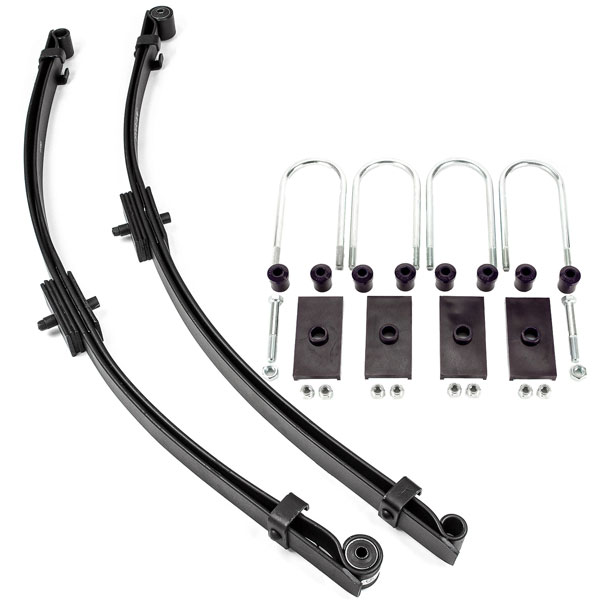
Lowering Blocks & Spacers
Lowering Blocks are designed to be used in conjunction with the rear leaf springs. They lower the vehicle's ride height by increasing the distance between the axle and the spring. If fitting in conjunction with telescopic dampers, clearance of the lower spring plates should be checked prior to use. Lowering kits offer an inexpensive way to lower your classic MG, subject to the existing springs being in good order.
 Left: H109, Right: H130
Left: H109, Right: H130
For MGC the front ride height can be adjusted by making adjustments to the vernier adjuster on the torsion bars, for method please refer to the MGC Workshop manual. Uprated MGC Torsion bars are available on request see part number AHC238.
 MGC Torsion Bars - AHC238
MGC Torsion Bars - AHC238
Lowering an MGF
The Hydragas suspension system comprises of four cannisters (one at each corner) filled with pressurised nitrogen gas and hydrolastic fluid separated by a diaphragm and damper valve.
When looking at the MGF, ride height for the standard car was nominally 368mm F/363mm R at a nominal 17 degrees centigrade (workshop temps) then plus or minus 10mm which was based on temp variation that accounted for 0.6mm change for every degree above or below that nominal 17 deg C, higher temp meaning higher ride, lower temp lower ride.
It is possible to depressurise the Hydragas units by removing some of the fluid from the suspension system. However, we strongly recommend not to add or remove fluid beyond the workshop manual settings. Other than altering the damping effect and spring rating, you can cause irreversible damage if the pressure is significantly reduced below 400psi. It is all too common to find a hard riding MGF is one where the nitrogen gas has partially or mostly leaked over the last 22 plus years, when the last new displacer was manufactured.
The Hydragas fluid pressure for these measurements was a nominal 400psi, but in practice you do find variation, BUT, if the car is suffering a noticeably hard ride and the ride height is lower and needs towards 500psi to regain most if not all of the lost ride height then this is pointing very clearly towards the inevitable loss of the nitrogen gas in one or more displacers. The gas was installed at a nominal 300psi and being a gas will compress under increasing pressure and this is the main spring for that displacers operation. Specialist re-gassing is the only way to recover a failing displacer and where one has degraded the others will not be far behind. If the car continues to be used with significant loss of gas then irrevocable internal damage will write off the displacer/s, leaving only a conversion to steel springs as a viable solution. Whilst we are aware of specialist regassing services we are mindful of the age and consequent likely detriation of the hydragas spheres and their internal rubber diaphragm that has taken place during that time. As this is a safety critical component we advise against their regassing.
 Hydragas operation diagram
Hydragas operation diagram
The easiest approach to lowering your MGF was to replace your existing knuckles with those fitted to the MGF Cup Racers however, the original MG Roversport knuckles (MGF427S) are no longer available. However, it should be noted that the Cup cars front and rear ride heights of 305mm and 310mm @ 400psi, was achieved in conjunction with competition displacers (MGF420S front and MGF421S rear). These had a different shaped alloy piston and the shaft of the piston was shorter than the standard cars. This shorter piston was the way the Trophy models achieved their 348mm/343mm F/R ride heights at the same 400psi.
.JPG?Sequence=238633&Width=600&Height=423) Image above of Trophy and standard displacer showing difference in piston length.
Image above of Trophy and standard displacer showing difference in piston length.
The original lowering knuckles available ten plus years ago would drop the cars' ride height to around 335mm/330mm F/R at the same 400psi. The image below shows the standard knuckle (RHF100070) and a lowered knuckle, where the difference is shown in the machining of the steel inner pin. Whilst the original lowered pin is no longer available, some suppliers offer an aftermarket version although it should be noted that we've heard varying reports as to their quality and lifespan.
 Left: Standard knuckle | Right: Aftermarket lowered knuckle
Left: Standard knuckle | Right: Aftermarket lowered knuckle
Another obvious way of lowering an MGF, is to shorten the standard displacers piston to copy the Trophy. Cutting a section off the end of the piston that retains the standard knuckle is the route that has been followed in Metro circles since not long after the Metro arrived in 1980. We strongly advise against making any modifications to the original piston lengths to maintain occupant safety and insurance liability.
With the Hydragas unit on MGFs being well over 20 years old, the preferred option to overcome unserviceable Hydragas units is to fit a replacement Hydragas suspension system which dispenses with the Hydrolastic spheres and makes use of a spherical spring enclosed in a canister and damper arrangement.
MGOC Spares offers a Hydragas replacement suspension kit for the MGF, originally developed by Suplex (H054) and now licenced to X-Part. These units give you the ability to adjust the ride height without the worry of piercing the nitrogen portion of the Hyrdagas unit. The instructions for how to convert your suspension system and make ride height adjustments whilst using the H054 kit can be found here.
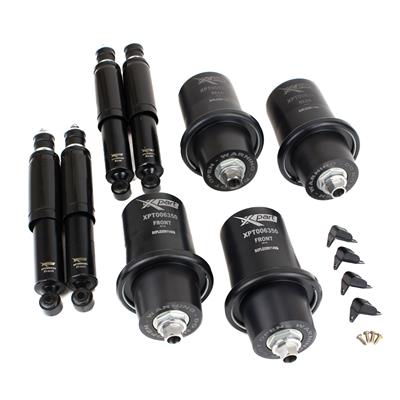
Suplex Hydragas replacement Kit - H054
Lowering an MGTF
The MG TF between 2002 and 2005 was offered in two options, a standard ride height of 358mm/353mm F/R plus or minus 10mm, or lowered ride height, known as Sportpack 1 with 348mm/343mm F/R. This being achieved by altering of the lower spring platform on the dampers. The same harsh spring and damper rates applied to both, which was not addressed until 2005 with the brief introduction of what came to be known as the 'soft ride suspension' at 358mm/353mm F/R, using 20% softer springs at the front and 30% softer at the rear. Not all cars had this spec before MG Rover went into administration as the Sportpack 1 lower suspension option remained available with the earlier model year spec. MG Motor picked up the soft riding spec for their cars between 2008 and 2011, and for their limited edition 85th anniversary model in 2009 fitted the Bilstein dampers with the Eibach anti-roll bar upgrade.
MGOC Spares is pleased to offer the original soft ride suspension kit (H053) manufactured by Tokico as used by MG Rover from chassis number 5D639631 onwards. Additionally, we offer the Bilstein "comfort handling kit" (H056) as used on the 85th anniversary cars which incorporates lower seat positions which give the user the ability to set the ride height.
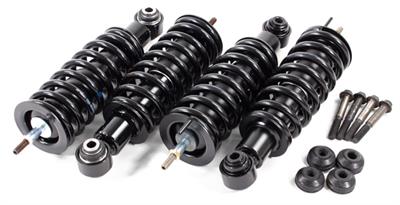
H053 - MG TF Factory Soft Ride Suspension Kit
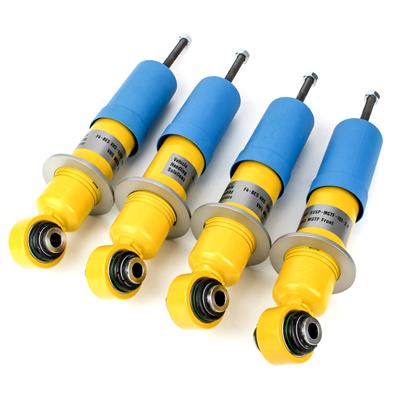
Bilstein Comfort Handling Kit - H056
Note. After carrying out work such as this, we strongly recommend you have your wheel alignment checked.
Who are MGOC Spares?
At MGOC Spares, we provide dedicated parts and accessories for classic MG vehicles, including the MGB, Midget, MGC and many more.
With thousands of products in stock, we are your one-stop shop for all your classic car needs. Our wealth of expertise means that you can trust us to find the right part for your classic MG vehicle – whatever it may be.
Need support finding the right parts for your MG? Contact us today, we're happy to help!